Thank you for visiting! By the way… any links on this page that lead to products on Amazon and other stores/partners are affiliate links Aquarium Store Depot earns a commission if you make a purchase.
Freshwater aquarium snails are common aquarium creatures that sometimes get a pretty bad rap in the hobby. There are pros and cons to keeping these inverts, but usually, there are a whole lot more benefits than drawbacks.
In this article, I’ll help you choose the right types of aquarium snails for your tank, and teach you what you need to know to keep them healthy. If you’re dealing with unwanted snails, you’ll find some great tips here too to help you keep them under control.
So let’s get started!
Good Vs. Bad?
What makes a good and a bad aquarium snail? Well, there are good and bad sides to most of the snails in the aquarium hobby. Many aquarists think of snails as fascinating pets that can be both beautiful and useful in the aquarium. Others don’t like them at all, especially when they find their way into the tank by accident and seem to take over!
Let’s take a look at some of the pros and cons of keeping these tank cleaners in your aquarium.
Pros
1. Snails do an excellent job of cleaning up leftover fish food and waste in the tank. They are the captains of the clean-up crew!
2. Snails eat algae- freshwater snails can help to keep your tank’s glass, plants, ornaments, and substrate looking clean and beautiful.
3. Some snails burrow into the substrate. Digging through the substrate releases trapped gas and also takes nutrients down to where plants need them. Snails can also clean the surface layer of the substrate to keep your tank looking great.
Cons
1. When snails breed out of control, they can actually add to the bioload of your aquarium, causing your tank to become overstocked and go out of balance.
2. It’s pretty rare, but some freshwater snails will feed on living plants.
3. A huge overpopulation of snails can look bad, and they can stick to the glass and leave snail eggs all over the tank too.
As long as you manage the cons, just about any aquarium snail can be a ‘good’ snail. That being said, certain species of snails do make much better choices than others.
The 7 Best Freshwater Aquarium Snail Species
There is quite a variety of snails available in the hobby at the moment, so choosing the right species for your tank can be a bit of a challenge.
In this article, I’m introducing the most popular types of freshwater aquarium snails and providing you with the most important information about them like:
- Scientific Name
- Size
- Origin
- Temperature
- pH
- Tank size
Although there are several species of snails available in the aquarium trade, these are the best species for planted tanks in particular. I consider these 7 types of snails to be the best options for most aquariums though, and they are great as species for community tanks as well. Below is a video from our YouTube channel. We go into further detail below. If you like our content, subscribe to us! You can use this information to help you decide which type of snail is best for your aquarium.
Let’s jump right in and meet these slow-moving aquatic friends!
1. Horned Nerite
Horned Nerite Snails are excellent algae eaters for planted tanks.
- Scientific Name: Clithon corona
- Size: 1 inch
- Origin: Southeast Asia
- Temperature: 72-82°F
- pH: 7.0-8.2
- Tank Size: 5+ gallons
Horned nerite snails are fascinating aquarium snails that come in a variety of colors and patterns. They are easily identified by the projections (horns) on the shell.
The color of their shells is pretty variable but often they have a cool black and yellow striped look. These snails eat algae and are great scavengers for freshwater aquariums.
Like other popular aquarium snails from the Neritidae family, these animals live in freshwater but need brackish water to breed. These peaceful snails are perfect for aquascapes because they do not eat live plants.
2. Zebra Nerite
Nerite snails are one of the best algae eating snails you can buy. Plant safe and do not reproduce in fresh water!
- Scientific Name: Neritina natalensis
- Size: 1 inch
- Origin: South Africa, Mozambique, Tanzania, Kenya, Somalia
- Temperature: 65-85°F
- pH: 6.5-8.5
- Tank size: 5+ gallons
Zebra nerite snails are one of the best aquatic snails for your planted aquarium. These animals look amazing and get their name from their beautiful striped shells.
It’s not only their looks that make them so great though, but they are also amazing algae eaters!
Nerite snails cannot breed in freshwater and rely on brackish water to reproduce. For this reason, you’ll never have to worry about this species overpopulating your freshwater aquarium.
3. Tiger Nerite
These Nerite Snails will eat algae, are plant safe, and do not reproduce in your aquarium!
- Scientific Name: Vittina semiconica
- Size: 1.5 inches
- Origin: Indonesia
- Temperature: 65-85°F
- pH: 6.5-8.5
- Tank size: 5+ gallons
Like the zebra nerite, tiger nerites won’t bother live plants or breed in your tank. These snails have a really cool golden orange shell with rows of interesting black markings.
They do occasionally lay eggs, but these aren’t going to hatch in a freshwater tank. Nerite snails are excellent algae eaters and they do a fantastic job of keeping the tank clean.
4. Malaysian Trumpet
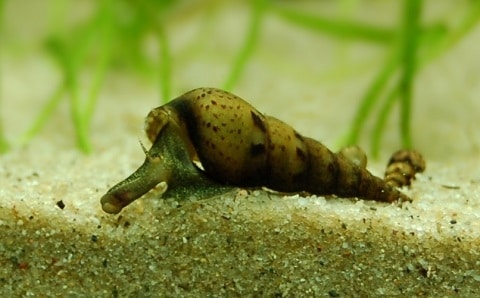
- Scientific Name: Melanoides tuberculata
- Size: 1 inch
- Origin: Southeast Asia
- Temperature: 72-86°F
- pH: 6.5-7.5
- Tank size: 3+ gallons
Malaysian Trumpet Snails are a species that many fishkeepers think of as pest snails. If you look at some of their benefits, however, it’s clear that there’s more to these crawling creatures!
They are burrowing snails that are great for managing the substrate at the bottom of your tank. All that burrowing prevents the build-up of toxic gases and helps to work nutrients into the soil which actually benefits the plants.
These animals aren’t for everyone though. Malaysian trumpet snails breed fast, are ultra-tough, and can be very difficult to remove, so think carefully before introducing them to your tank.
5. Mystery
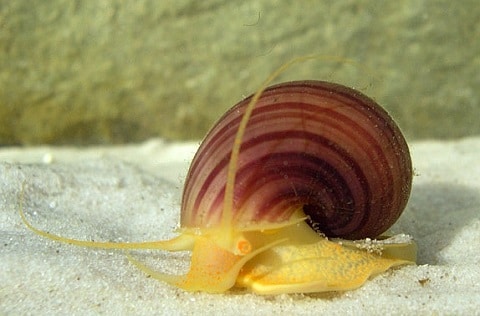
- Scientific Name: Pomacea bridgesii
- Size: 2 inches
- Origin: Brazil, Bolivia, Paraguay, Peru
- Temperature: 68-82°F
- pH: 7.6-8.4
- Tank size: 5+ gallons
Mystery Snails are awesome cleaners that will eat any leftover food in the aquarium. They are large snails but are super peaceful and work great in shrimp tanks. Mystery snails are also known as Gold Inca snails.
Mystery snails can be bred in the aquarium, but unlike other types of snails, their eggs must be laid outside of the water. This requirement, together with the fact that you need a male and female to breed, means they are easy to control and won’t multiply unless you make it possible.
6. Rabbit
A snail with a head that resembles a rabbit. Great for keeping the substrate tidy and clean. It can grow up to 4" inches in size
- Scientific Name: Tylomelania spp.
- Size: 2-4 inches
- Origin: Indonesia
- Temperature: 76-84°F
- pH: 7.2-8
- Tank size: 30+ gallons
Rabbit snails look kind of like a jumbo Malaysian trumpet snail. The head of this species resembles a rabbit’s head, and that’s where they get their name.
There are several species of rabbit snails available. These big snails come in a few cool color morphs and won’t multiply like trumpet snails. Although it isn’t usually a problem, rabbit snails have been reported to feed on some aquarium plants like Java Ferns.
These snails are great for cleaning up the tank and also keep the substrate healthy by burrowing. Because they grow pretty big, these snails are best for larger fish tanks of 30 gallons or more.
7. Ivory
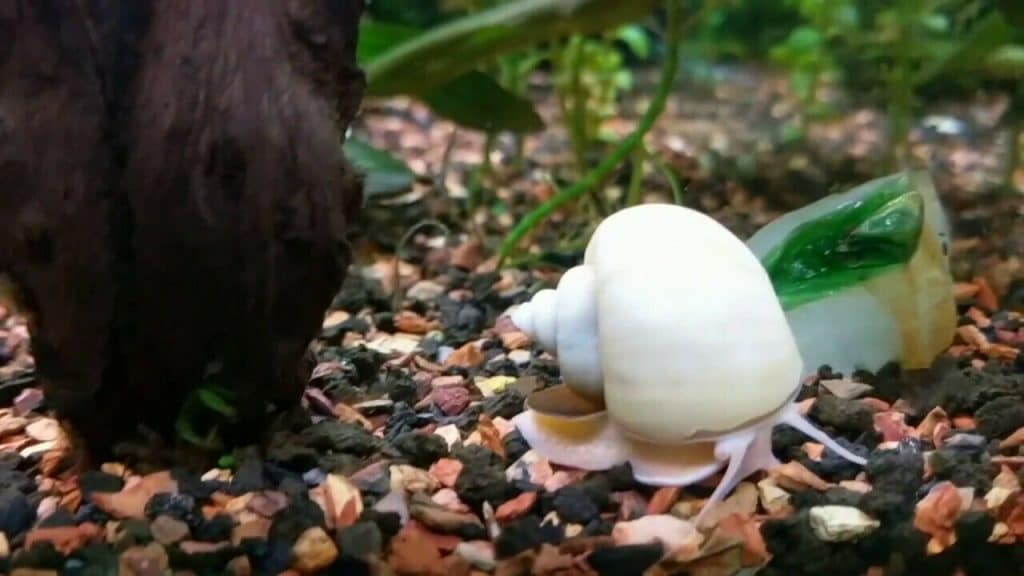
- Scientific Name: Pomacea bridgesii
- Size: 2 inches
- Origin: Brazil, Bolivia, Paraguay, Peru
- Temperature: 68-82°F
- pH: 7.6-8.4
- Tank size: 5+ gallons
If you like Mystery Snails, but want something a little more exotic for your planted tank, the Ivory Snail might be the perfect option for you. These awesome-looking snails are the same species as the regular Mystery Snail but have been bred to have pure cream-white shells and pale white bodies with pink and orange markings.
Ivory Snails also have all the same great benefits for your tank as the regular Mystery Snail. These active snails will search your tank for algae and uneaten fish food and are completely peaceful with their tankmates.
The 4 To Avoid
The species in this list tend to be those unwanted snails that aquarists try to get rid of. They do have their positive sides, so I’m not calling them straight-up villains here.
Instead, you are recommended to be very cautious about adding them to your tank and rather try out some of the other snails listed above. You see our video below if you want to see these snails in action. Please subscribe to our YouTube channel if you like content like this.
1. Bladder

- Scientific Name: Physa acuta
- Size: 1/2 inch
- Origin: Uncertain
- Temperature: 64-84°F
- pH: 7-8
- Tank size: 3+ gallons
Bladder snails (video source) are a freshwater snail species that many aquarists have in their tanks. However, these snails aren’t usually added to fish tanks by choice!
These distinctive-looking snails have the ability to breed fast, and since they are hermaphroditic, you only need one to start a colony. Bladder Snails don’t dig and they breathe air from the surface, although they spend most of their time cruising around on surfaces in your tank.
They feed on algae, waste, and uneaten food but do not damage plants. They will feed on damaged or dead plant matter, however.
2. Ramshorn
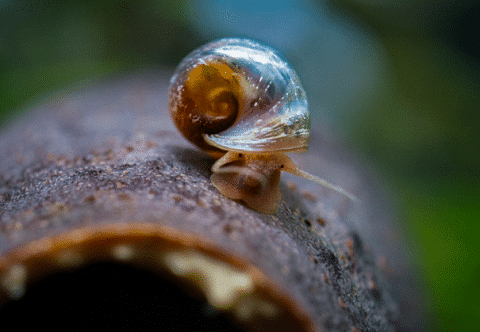
- Scientific Name: Planorbarius duryi
- Size: 1 inch
- Origin: USA
- Temperature: 60-80°F
- pH: 7.0-7.5
- Tank size: 5+ gallons
Ramshorn snails often find their way into aquariums accidentally on new plants. They are one of the most common pest snails in the aquarium trade.
Ramshorn snails are very peaceful but breed freely, which can be pretty annoying if you never planned on having them in the first place. Ramshorn snails are hard workers in freshwater aquariums, however, and have awesome multicolored spiraled shells.
They are not fussy about food and are happy to scavenge and feed on uneaten fish food. They will also eat algae but do not feed on live plants. They are known for eating black beard algae.
3. Assassin
- Scientific Name: Clea helena
- Size: 1-2 inches
- Origin: Thailand, Indonesia, Malaysia
- Temperature: 75-80°F
- pH: 7-8
- Tank size: 29+ gallons
Assassin Snails are the cannibals of the snail world. These carnivorous mollusks feed on other snails, so most aquarists keep them to help control the population of pest snails in their tanks.
For that purpose, they are great, but if you like your snails, avoid introducing assassins to your tank! Although it is rare, they will sometimes feed on freshwater shrimps in the aquarium as well.
Usually, however, they will only feed on dead or dying shrimps, and even dead fish. If you don’t have other snails, you can still keep this species if you provide them with a high protein sinking food like bloodworms.
4. Apple

- Scientific Name: Pomecea canaliculata
- Size: 2-3 inches
- Origin: Brazil, Paraguay, Uruguay, Bolivia, and Argentina
- Temperature: 65-82°F
- pH: 7-8
- Tank size: 10+ gallons
Apple snails (image source) have crawled onto this list of snails to avoid for two reasons, they have a habit of eating live plants and they are invasive.
To be fair, apple snails can make an interesting pet in tanks without any live plants, but they should be kept far away from your aquascapes.
Apple snails have escaped captivity and become invasive in many parts of Asia and the Southeast of the USA. They will probably invade other parts of the world if they are allowed to, so please remember to be responsible and never release them (or any other aquarium plant or animal) into the wild.
How To Care
Most types of snails are really easy to care for and will thrive in your fish tank without any extra effort from you. They will do best in a healthy and stable environment though, so here’s some basic information on how to provide them with a great home.
How To Set Up Your Tank
Aquarium and pond snails can be kept in just about any tank size, although the larger species obviously need more space. Assassin snails, for example, will do best in larger tanks with more stable conditions.
Good filtration is very important for keeping healthy aquariums. Although many snail species can survive in lower water quality conditions, running a good quality filter will keep the water looking and smelling pristine. Filtration is also super important if you plan on keeping other animals like shrimp and fish.
To keep the water temperature stable in your aquarium, you will need to install an aquarium heater. Make sure you set your heater to a temperature that your species of snail is comfortable in. A thermometer is also very useful because it allows you to monitor the water temperature in your tank.
Some types of snails, like nerites, for example, will often crawl out of the water and can easily escape your fish tank. Make sure you have a secure lid/hood over your tank to prevent them from escaping and getting lost or hurt.
What To Feed Them
Most aquarium snails will live happily in your aquarium without needing to be fed specifically. Here’s what they eat:
- Uneaten fish food
- Dead plant matter
- Soft algae
- Fish waste
This makes keeping your snails happy and well-fed really easy. If you don’t have enough of those food sources available to your snails, you can also feed them some bottom feeder tablets, or even some blanched green vegetables.
Providing an extra food source is definitely recommended if you keep a lot of algae-eating snails like nerites and they run out of food. If this happens, it is even possible to grow algae for them to eat.
Where To Get Them
Many fishkeeping stores have a few of the more common snails available for sale. For a great variety of cool aquarium snail species from an online fish store, I would suggest checking out Flipaquatics. The team at Flipaquatics takes great care of their stock to ensure your new pets arrive in perfect shape.
How To Avoid Introducing Nuisance Varieties To Your Aquarium
Snails often find their way into aquariums, whether we introduce them intentionally or not! It is easy to prevent this from happening though, so let’s start by looking at how they sneak in.
How Can They Get Into Your Tank?
The first thing to note is that snails can get into your aquarium as adults, or as eggs. Any time you add something to your aquarium that has been in another aquarium, you run the risk of adding snails.
This includes the tanks at your local fish store or even your friends’ tanks. Adding things to your tank from wild sources like ditches, lakes, or rivers is also a risk.
Snails and their eggs are usually attached to new plants, ornaments, gravel, or basically anything from another tank. Snails are really tough as well, so even if an object has been outside of a tank for some time, the snails can still survive.
Another way that snails can arrive is when you introduce new fish to your tank. Sometimes a little gravel gets scooped up and bagged along with your new fish, and sometimes a snail or two can be part of the deal.
Tips To Keep Them Out
Adding new plants is one of the most common ways that pest snails are introduced to fish tanks. Before adding a new plant to your aquarium, check it thoroughly and rinse it off, removing any snails or eggs you might see.
Next, prepare a bleach dip consisting of 1 part bleach to about 20 parts water. Dip soft plants in the solution for no more than a minute and firm plants for up to two minutes. Afterward, rinse the plants off carefully with conditioned water before planting them out.
A much easier way to safely add new plants is to buy tissue culture specimens. These are plants that are carefully grown under special lab conditions to ensure that they are pest-free. They are not always easy to find, so check out online retailers like Buceplant for a great range.
Buce Plant offers a wide variety of aquatic plants for sale. With one of the largest selections in the US, you will find what you need here. They are also a great source for freshwater shrimp!
How To Get Rid Of Nuisance Varieties
Before starting an all-out war with the snails in your tank, remember the great benefits they provide. Often, it’s best to keep them around but keep the numbers down to a reasonable level.
Managing the snail population in your tank can be surprisingly easy if you understand this one simple truth about snails: the more food they have, the more they will breed! So how do you reduce the amount of food available to the snails?
Reducing Their Food Supply
Well, start by making sure you are not overfeeding your fish. If there’s limited food for the snails, their numbers will stay stable.
It is very important to maintain good water quality in your tank by performing regular water changes and tank maintenance. This is the best way to keep the nutrient levels low in the water.
Another great way to reduce the nutrients in your aquarium is to grow fast-growing aquarium plants that will soak up excess nutrients and turn them into healthy new leaves!
Physical Removal
Here’s a great tip for actively managing the snail numbers in your tank: you can bait them with algae wafers or even a piece of lettuce or some other leafy green.
Set the bait into a small dish on the bottom of the tank, and weigh it down so that the snails can access it. Leave the dish in the tank overnight, and remove it the next morning when it is crawling with snails!
Introduce Assasin Species
Introducing another species of freshwater aquarium snail to your tank might seem like a terrible way to reduce your pest snail population. Assassin snails are one kind of animal that can really help though because they eat other snails.
Fish That Will Eat Them
Whether you want to keep your pet snails safe from hungry fish, or are looking for a way to remove unwanted pests from your aquarium, knowing which species of fish eat snails is very useful! The following fish species are notorious snail-eaters that can help remove pest snails from your tank.
- Clown Loach
- Skunk Loach
- Yoyo Loach
- Carnivorous Cichlids
- Freshwater Pufferfish
- Goldfish
Fish That Are Compatible with Them
For the snail-lovers out there, it can be devastating to see your pets eaten by their tank mates. Fortunately, most peaceful community fish will get along fine with snails, as long as they prefer the same water parameters.
Smaller nano fish are usually a safer bet than larger fish, and shrimp are also great tank mates. Fish have a mind of their own of course, and there are no 100% guarantees, but as long as you avoid the fish listed above, your snails should be safe.
FAQS
Are they good for your fish tank?
Snails provide a bunch of great benefits for your tank. Apart from the few species that feed on plants, snails are usually a hardworking member of your clean-up crew.
How big do they get?
The maximum size of aquarium snails varies hugely, depending on their species. Bladder snails, for example, only measure about 1/2 an inch across, while mystery snails can reach golf ball size!
Can you have a tank of just them without any fish?
Sure, if you’re interested in keeping snails only, there’s nothing wrong with that. You can add a few live plants and a basic filter and you will have a very interesting invert tank.
How do I know what kind I have?
Most of the common aquarium snails are pretty easy to identify once they have reached full size. The color, markings, and shape of the shell, as well as the color and form of the body, are the best way to identify these creatures.
How long do they live?
The lifespan of aquarium snails varies, depending on their species and how healthy their water parameters are. You can expect most types of aquarium snails to live at least 1 to 3 years.
Final Thoughts
Love them or hate them, aquarium snails are something that most aquarists and fishkeepers will come across sooner or later. Some might be pests, but many of them are very cool additions to community tanks and planted aquariums.
Whether you’re looking to add new snails to your tank or get rid of them, I hope this guide helps you out! Please comment below if you have any questions.
- About the Author
- Latest Posts
I’m thrilled that you found Aquarium Store Depot! Here you’ll find information on fish, aquariums, and all things aquatics related. I’m a hobbyist (being doing this since I was 11) and here to help other hobbyists thrive with their aquariums! I adhere to a high quality Editorial Process and Review products with real life field usage and practical analysis.



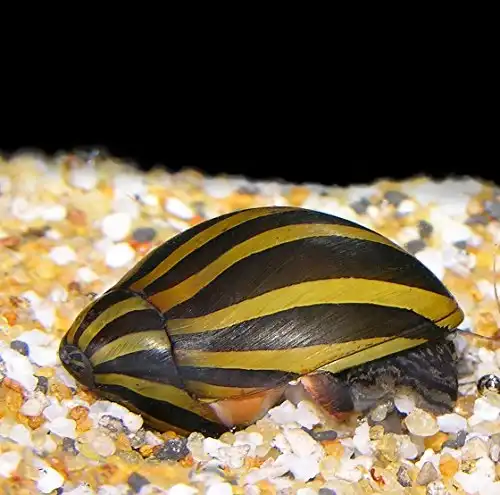

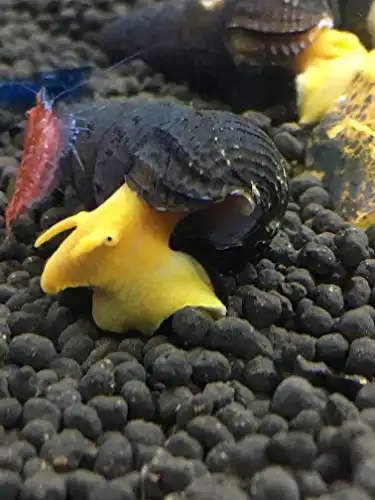





thanks for the info.. I’ve got 2 tanks wh only plants and was wanting to go a diff route than fish. snails sound like the perfect addition to one or both of them. i have ordered freshwater clams for one tank and they should go nicely wh them and probably cherry and tiger shrimp in the other.
Nice blog!Thank you for sharing informative content.
Hi Mark,
Thanks for the snail info. I have 2 small nerites that I would like to send to my daughter in another state. Can these be sent via overnight fedex/ups shipping? I imagine they would need to be protectively packaged, but I can’t locate any information about it.
Yes, they can be shipped. I would reach out to sellers like BucePlant or Algae Barn to see how they ship their’s. Follow their best practices. It’s pretty expensive to ship livestock.
Good info
Thanks
Totally enjoyed your informative knowledge of snails.